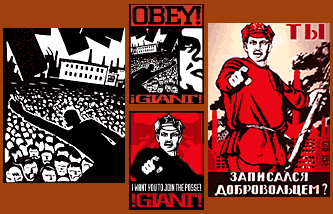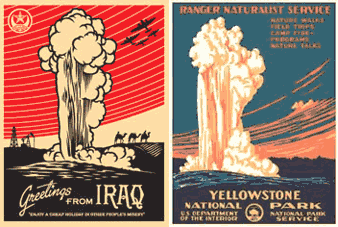I'm starting to get intrigued by the case of Shepard Fairey, the artist who created the now-famous "Hope" image of Barack Obama and is now being sued by the AP because he copied Obama's image from one of their photographs.
Fairey doesn't deny that he used this photograph:
as the basis for this poster:
What he argues is that this falls under Fair Use and I expect he has a pretty good chance to win his case. Here are the "four factors" that a judge must way in determining whether Fair Use applies:
1) the purpose and character of theuse
2) the nature of the copyrighted work
3) the amount and substantiality of the portion taken, and
4) the effect of the use upon the potential market.
Under (1), I think Fairey is on strong ground in claiming that he has significantly transformed the original, enough to make it a new creation, with a new meaning that the original did not have. It might not be the most technically impressive transformation - actually, it looks pretty easy and (see below) that would be perfectly in character for Fairey - but it's still a different work than the photograph.
(2) Fairey is emphasizing his view that the photograph is a strictly factual piece of work, not a creative one. Now there's a fine way to insult the entire field of photography and that certainly won't win him any friends. The classic case involved a ruling that phone books could not be copyrighted, as they consisted of purely factual data, but it would be nuts to rule that all photojournalism is no more creative than a phone book. Fairey's on shaky ground with this one.
(3) Fairey has not reproduced the entire photograph, but merely the portion that interested him. I doubt this factor will weight very heavily either way.
(4) You could try to argue that Fairey's work damages the market for the original photograph, but I'm afraid the "giggle test" would trip you up here. The photo had already been filed away under "stock" and no one was asking for it specifically until Fairey made it famous (not - see below - that he intended to).
All in all, I predict that (if the case goes to court) Fairey would win on point 1 and 4, with 2 not being consequential enough to outweigh the other factors. Which would be a nice defense of Fair Use, a principle that is under relentless attack these days.
Unfortunately, it could certainly have happened to a nicer guy. I came across a reference to this attack on Fairey, by artist Mark Vallen, who makes a convincing case that Shepard Fairey is a serial plagiarist who routinely copies other's work, not because he has something to say about that work, but simply because he is "too lazy to come up with an original artwork." He provides over a dozen instances where Fairey obviously copied a work, slapped his own slogan on it, and then passed it off as an original work. In this example:
Fairey's work is in the center and the unacknowledged originals are on either side. That's not transformation; that's just plagiarism. After all, how lazy do you have to be to copy a drawing of an Old Faithful eruption, when you need a picture of exploding bombs: 
Not that a WPA poster is likely under copyright - government work, by law, is not. Some of the other work that he's stolen is protected, though, and Fairey's had to withdraw some of his t-shirts when rights-holders objected. Lucky for him, AP's case is not so strong and his Obama poster will likely pass muster as an original work. It might be a first.
Thursday, February 12, 2009
That Obama image
Labels:
art,
intellectual property
By
Scott Hanley
![]()
![]()
Subscribe to:
Post Comments (Atom)


1 comment:
I agree he seems to be a lazy copier.
Post a Comment